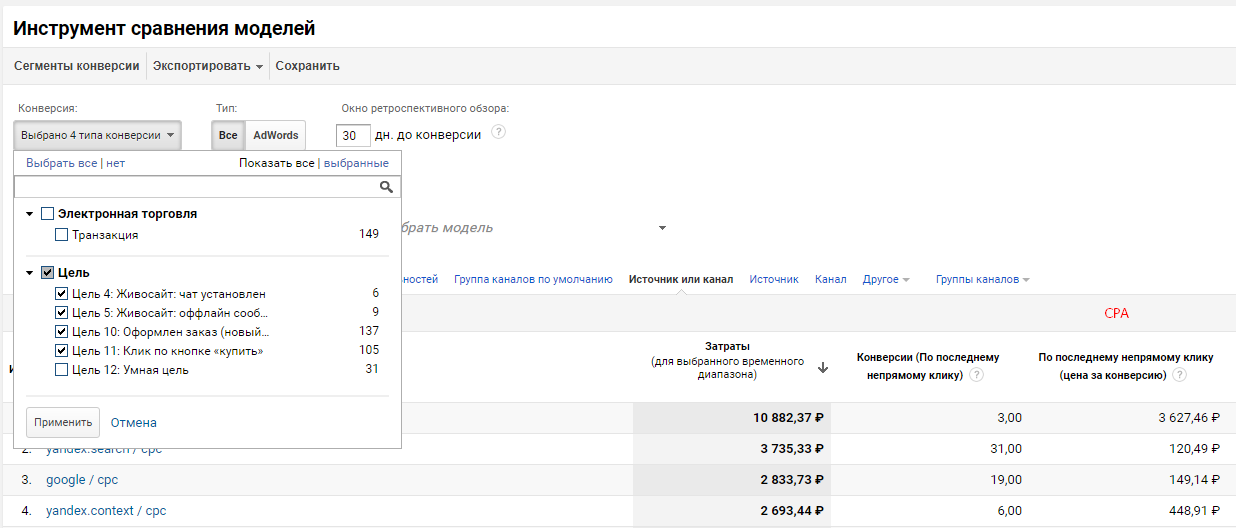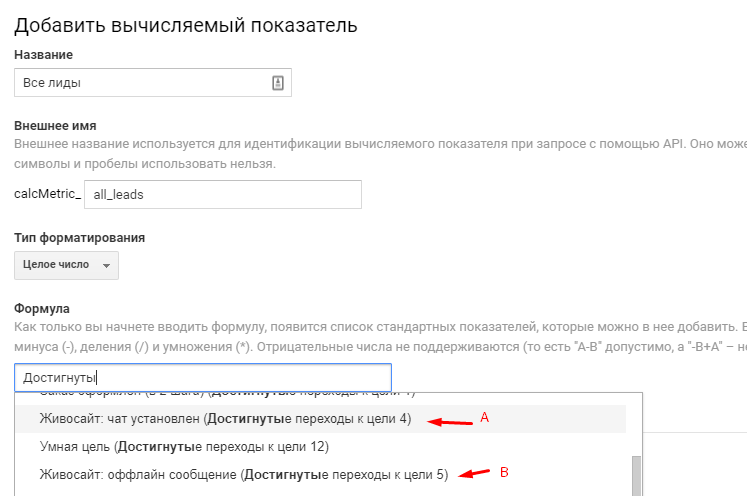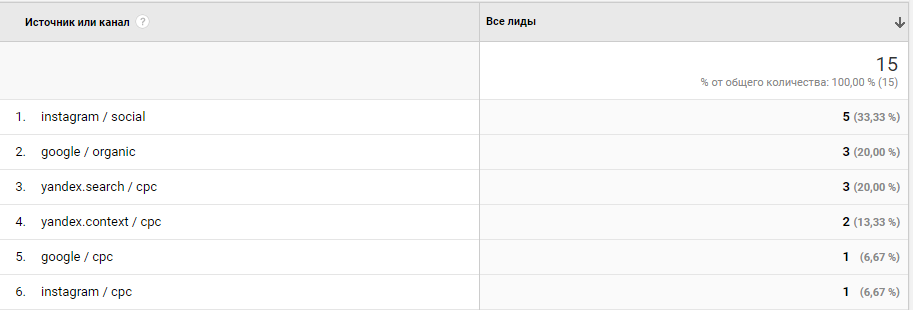What metrics to rely on, if users perform few conversions on the site?
We enter the mini-case format, where my colleagues and I deal with one specific problem and give advice. The main requirement - to save water for good purposes, to give squeeze.
Problem: how to conduct some kind of testing, evaluation of experiments, if there are few conversions on the site?

Chose a month period, all users.
Few conversions - little data. Any conclusions in this situation are not much different from guessing on a daisy or consulting with the secretary.
For example, we are trying to test the hypothesis “Users from Moscow are converting better than users from regions” , we include the corresponding segment and get a single vertex. The analyst is crying.

Here is how Muscovites are converted.
To save the situation, we try to unscrew the period for a quarter or a year, but we rest on restrictions:
When I encountered such a problem, there was nothing left but to roll down to behavioral metrics and analyze in terms of failures and time on the site. But these are not indicators that should be taken seriously in such an analysis.
Internet marketers recommend in this situation not to mark 2 goals, but all micro-conversions that hint at the user's “warmth”:
And this is not a solution to the problem.

Additional goals are poorly converted.
You can make 20 goals, but if each converts so-so, no analysis will come out. We will make a decision, relying on those who put in the basket, or those who ordered a callback? And no matter what we choose, it goes against logic and statistical significance — too little data .
This also applies to traffic sites, where the user has plenty of options for ordering: from the classic shopping cart to the vibe. A large number of transactions is spread over the goals and again we get a lack of data - we have to spend more time before making a decision.
We form a composite goal and consider that a person is “hot” if he has fulfilled at least one goal from the list
The main thing is not to add something strange to the list that instantly turns the “hot” audience into “barely warm”, for example, the “Viewed 2 pages” goal, then the conversion will easily reach 50%, but to sense.

An example of a customized goal that captures any target action and counts the conversion to the user.
Now, whatever the user from this list does, the conversion counts and I understand that he is mine, lukewarm :) The analyst jumps for joy, because now he has enough to test the hypotheses data.
The flexibility and capabilities of the system please. If you have few conversions, you can
In a series of reports, Analytics allows you to select the desired goals for analysis: the conversions for them are summarized. For example, the report “Conversion → Attribution → Comparison Tool”

Favorite report on attributions, where goal achievements and CPA are visible. We select the necessary and we look at the table.
In the setting of representation "calculated measure", we add the desired goals A + Bed and the C + . To calculate the conversion: (A + B + C) / Sessions The

user metrics can only be seen in your own reports, we create them in “Special Reports → My Reports”. I only derived this metric for an example.

I think this is a bad idea. I admit as an additional signal, but not a complete replacement of targets, and here's why.
Smart goals were originally created as an aid to optimizing Adwords advertising campaigns. And for those advertisers who are not even able to mark their goals on the site.
Quote from help :
And, hell, Analytics really well isolates a high-quality audience, but the “low-quality” audience also brought conversion and revenue.

Qualitative audience under the flag of "Yes"
If we optimize advertising with an eye on only this indicator, will we not drop the number of orders? We did not use "smart goals" as a reference point in the optimization of advertising campaigns, so the thought above is an assumption. The decrease in CPO is, of course, good, but only when the quantity O (rders) does not fall at the same time as rapidly. So after all, you can play around and leave business without work.
Problem: how to conduct some kind of testing, evaluation of experiments, if there are few conversions on the site?

Chose a month period, all users.
Few conversions - little data. Any conclusions in this situation are not much different from guessing on a daisy or consulting with the secretary.
For example, we are trying to test the hypothesis “Users from Moscow are converting better than users from regions” , we include the corresponding segment and get a single vertex. The analyst is crying.

Here is how Muscovites are converted.
To save the situation, we try to unscrew the period for a quarter or a year, but we rest on restrictions:
- targets have been added recently and there are no statistics for them, or
- decisions need to be made quickly in the future, testing hypotheses for 3-6 months is wasteful
When I encountered such a problem, there was nothing left but to roll down to behavioral metrics and analyze in terms of failures and time on the site. But these are not indicators that should be taken seriously in such an analysis.
Internet marketers recommend in this situation not to mark 2 goals, but all micro-conversions that hint at the user's “warmth”:
- wrote to an online consultant
- ordered a call back
- downloaded price
- signed up for installation / metering / test drive
- added to cart
- looked over 20 pages, etc.
And this is not a solution to the problem.

Additional goals are poorly converted.
You can make 20 goals, but if each converts so-so, no analysis will come out. We will make a decision, relying on those who put in the basket, or those who ordered a callback? And no matter what we choose, it goes against logic and statistical significance — too little data .
This also applies to traffic sites, where the user has plenty of options for ordering: from the classic shopping cart to the vibe. A large number of transactions is spread over the goals and again we get a lack of data - we have to spend more time before making a decision.
Solution based on Yandex Metrics
We form a composite goal and consider that a person is “hot” if he has fulfilled at least one goal from the list
- or place an order
- or put in the basket
- or wrote to the consultant
- or did something else useful
The main thing is not to add something strange to the list that instantly turns the “hot” audience into “barely warm”, for example, the “Viewed 2 pages” goal, then the conversion will easily reach 50%, but to sense.

An example of a customized goal that captures any target action and counts the conversion to the user.
Now, whatever the user from this list does, the conversion counts and I understand that he is mine, lukewarm :) The analyst jumps for joy, because now he has enough to test the hypotheses data.
And what about analytics?
The flexibility and capabilities of the system please. If you have few conversions, you can
Nothing to do
In a series of reports, Analytics allows you to select the desired goals for analysis: the conversions for them are summarized. For example, the report “Conversion → Attribution → Comparison Tool”

Favorite report on attributions, where goal achievements and CPA are visible. We select the necessary and we look at the table.
Create a common goal by analogy with Metric
In the setting of representation "calculated measure", we add the desired goals A + Bed and the C + . To calculate the conversion: (A + B + C) / Sessions The

user metrics can only be seen in your own reports, we create them in “Special Reports → My Reports”. I only derived this metric for an example.

Create a “smart target”
I think this is a bad idea. I admit as an additional signal, but not a complete replacement of targets, and here's why.
Smart goals were originally created as an aid to optimizing Adwords advertising campaigns. And for those advertisers who are not even able to mark their goals on the site.
Quote from help :
Using machine learning, smart targets process dozens of signals associated with sessions on the site to determine which of them most often lead to conversions. Signals such as session duration, pages per session, location, device, and browser are taken into account.Analytics on behavioral metrics is trying to understand which audience is better and should be better converted. Adwords is trying to buy more of this audience. You should probably experience a strong reduction in order value (CPO) from this channel.
And, hell, Analytics really well isolates a high-quality audience, but the “low-quality” audience also brought conversion and revenue.

Qualitative audience under the flag of "Yes"
If we optimize advertising with an eye on only this indicator, will we not drop the number of orders? We did not use "smart goals" as a reference point in the optimization of advertising campaigns, so the thought above is an assumption. The decrease in CPO is, of course, good, but only when the quantity O (rders) does not fall at the same time as rapidly. So after all, you can play around and leave business without work.
